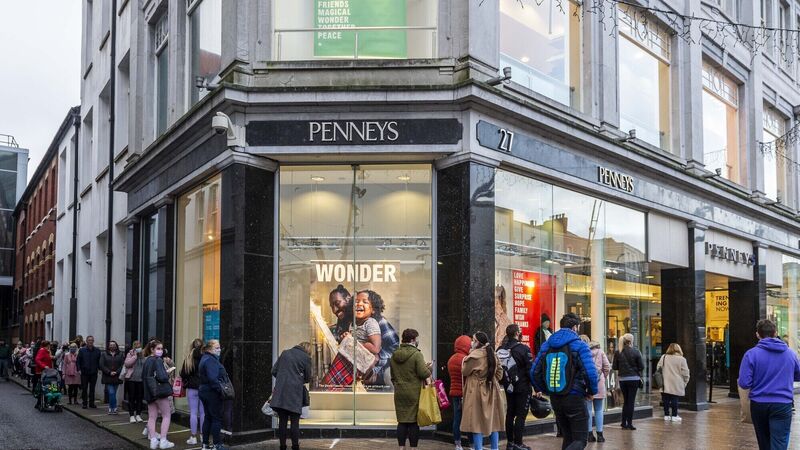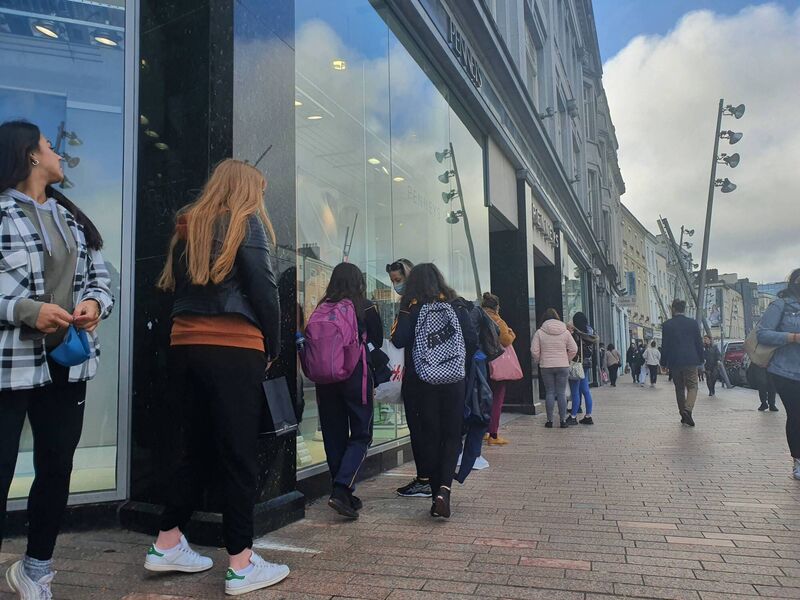Why Penneys will emerge from Covid-19 stronger than before

The queue for Penneys on St Patrick Street last December. Picture: Andy Gibson
It’s a house of cards on the high-street with every month bringing more bankruptcies and job losses. Arcadia has fallen into administration, Zara, H&M, and M&S have all laid-off workers and closed stores across the globe.
While the news from the high-street appears to be bleak, Irish high-store Penneys or Primark appears to be weathering the Covid squall releasing news that it still expects Primark’s full 2020/21 sales and profits to be higher than previous year’s.
It comes as Penneys' confirmed its flagship store in Cork has major plans for expanding its offering at the block it occupies.
The fast-fashion retailer confirmed to the Irish Examiner that, pending a successful planning outcome, it intends to increase its retail space by almost 50%, adding 17,000sq ft to its existing 37,000sq ft, and the store will not close during the expansion, which will take place on a phased basis.
Primark owner Associated British Foods’ finance chief John Bason told Reuters: "It's very clear that our trading before the lockdown and now our trading these first few days after lockdown (is) way higher than we had previously expected."
It is even more exceptional considering all of Primark stores globally were forced to shut. And unlike most of its high-street adversaries, Primark has no e-commerce operation, meaning it missed out on that lockdown online windfall, losing €755m per month in sales during the first Covid lockdown. Green Party Cllr. Carolyn Moore points out: "Where some other large retailers enjoyed an online boom during the lockdown because people were sitting at home and ordering online, people didn't have access to Penneys while their bricks and mortar stores were closed."

Surpassing trading expectations, Primark owner Associated British Foods previously forecasted a €435m sales hit from forced store closures.
But what the closures did do was cause a flurry of pent-up demand that resulted in enormous queues in front of its thirty-seven stores across Ireland when they reopened on Friday, 12 June and again on December 1st. They were the days that, it seems, a lot of Ireland had been waiting for - the chance, after weeks of shuttered stores - to finally be able to return to Penneys.
Shoppers were willing to join lines around the block to get in. One of the most anticipated store re-openings, eager shoppers, press, security staff, and gardaí surrounded the country's stores early. Associated British Foods finance chief John Bason told Reuters that Penneys Irish branches broke their daily sales record for two days in a row in December. Deputy editor of STELLAR magazine and author of 'Thanks Penneys,' Valerie Loftus explains the demand.
"I went in a week or two after it opened back up and spent almost €100 on stuff like socks, pyjamas, face cloths - all those little things that are harder to source than you'd think. Penneys is always a safe bet, and people missed the ease of popping in for a look."
At Dublin's Henry Street flagship store - around 150 shoppers queued from early morning. The store was due to open at 10.30am, but allowed shoppers in at 8.45am, as advised by the gardaí.
The average basket size of shoppers returning to stores was initially significantly higher than last year, reflecting some pent-up demand. While this outperformance has been reduced in recent weeks, it remains higher than a year ago. Cllr. Carolyn Moore attributes this to changing consumer habits, with people reducing the number of shops they visit and attempting to do a one-stop-shop.
"With Covid changing how we shop, and queues becoming the norm and restrictions in store, it's entirely possible people will aim to get as much as they can in one store instead of going from shop to shop like they used to."

Penneys turned 50 last year, but there's nothing middle-age about the Irish fashion brand with over 380 stores worldwide. Over 16 million square feet of selling space across thirteen countries, and naturally, a cult-like following.
"Convenience and price undoubtedly have always played a huge part in the appeal of Penneys," Moore says.
And Penneys has been providing customers with competitively costing clothes since 1969 - when the first store opened on Mary Street in Dublin's city centre by retailer Arthur Ryan, on behalf of the Weston family. Ryan relinquished his chief executive duties in 2009 after forty years but stayed on as chairman. Ryan passed away at the age of 83 in July of last year and is often credited with masterminding the clothing chain's incredible growth.
Offering low-cost, high-style items, or amazing fashion at amazing prices as their tagline states, Penneys was one of the first retailers to bring democracy to the high-street, proving that anyone can look stylish on a budget. That attainability and accessibility remain at the core of its long-standing success today. Loftus agrees.
"There used to be a bit of Penneys snobbery back in the day, but I've noticed less and less of that since they majorly upped their game, fashion-wise. In that sense, I think it is a unifier - no one can resist a bargain or snap up a new trend for the cost of a coffee. It's also not exclusive to Dublin or Cork or Galway, and that accessibility is key."

Appealing to everyone from mothers to teenagers, Penneys' cheap and cheerful model was swiftly adopted by the Instagram age where hauls and outfit posts became de rigueur. Instead of investment pieces, the pressure was on to update social media with the latest trends and must-have pieces. But, particularly since lockdown, change has been felt, purchasing habits have shifted, with people reflecting on what matters, and this often doesn't mean bulk-buying the latest trends.
A Penneys spokesperson admits that the pandemic has given them the chance to accelerate their plans in the area of sustainability, which they have been working on for over a decade.
And it seems Penneys aren't the only ones feeling the effect of the sustainability reawakening. Instead of Youtubing their latest fast-fashion hauls, influencers are now embracing sustainability, highlighting Secondhand September, an initiative started by Oxfam that encourages people to shop only second hand for 30 days or more. According to the global fashion search platform Lyst, fashion searches that include 'vintage' and 'second hand' have risen significantly since the start of September – they're currently up 11% week-on-week.
"People are creating their own little circular economies, with markets and Depop stores and clothes swaps, they're recognising that they have to to buy less and keep what they have in circulation for longer," Moore adds
Before, shoppers didn't consider where their clothing originated. But with more access, we are more informed about ethics and sustainability than ever, and many are wising-up and embracing a buy less and buy better mantra. And this ethos is vital to adopt, says Moore, who suggests that we can slow down our consumption and shopping habits.
"What every single one of us can do is buy less, and now thanks to social media we have direct access to brands too, so tell them what you want. It's their business to respond to customer demand."
Little by little, the high-street is listening and acknowledging consumer's demands on sustainable style. Loftus says: "People are a lot more conscious of the impact of fast fashion on the environment, and are demanding more from retailers on that front."
For the past few years, high-street stores, including Zara, H&M, Mango, and Penneys, all include eco-friendly collections as part of their output. But are these just token gestures, green-washing, or are they finally addressing environmental wastage, manufacturing, and the fast-paced nature of fashion itself?

Penneys admits it is stepping up its sustainability initiatives. Building on plans already in place, it pledges to remove all single-use plastic from their business, increase the use of recycled materials across their product ranges, and commit to educating and training cotton farmers on more environmentally friendly farming practices.
"While we have been on a journey to become more sustainable for many years, we recognise that our work to date did not match our ambitions. And we know that our customers and the 70,000+ employees who work for us, want us to do more in this space."
Just this month, Penneys launched a campaign that features new, sustainable everyday essentials. Sticking to their mantra, the products featured in the campaign tick the trend and price boxes. The press release states: "A Better Future campaign is the next step in making it easier than ever for style-conscious shoppers to make a more sustainable choice, at amazing prices."
It seems if Penneys are going to do sustainability, they will do it their way, bringing their dose of democracy that made them a success, now to sustainability.
"We are committed to becoming a more sustainable company, but we want to do it the Primark way. Primark was founded on the idea that fashion should be affordable to everyone, and we're proud of our prices. That ethos should extend to our sustainable fashion as well.
Right intentions are important, but so is action; the fashion industry as a whole has to adapt and alter. As integral to ensure a clean and ethical production of clothing, business models in terms of how much is produced needs to reflect sustainability goals. That means churning of product and production of an excess amount of stock needs to stop or slow down at least.
"These companies have to realise that producing too much of anything and encouraging more than they need is fundamentally unsustainable, and the consumer also has to realise that if you're buying 40 or 50 garments a year, it doesn't matter if they're ethical, that level of consumption can never be good for the environment," Moore says.
Therefore, retailers should have a certain responsibility to educate customers to ditch the throwaway and wear once mentality by creating products that you can reuse or re-wear. Loftus agrees, saying: "The message we've received for quite some time now is that cheaper clothes are disposable - buy them, wear them once, then forget about them. I can't imagine fashion retailers suddenly deciding to pare back their stock and encourage responsible consumption, but stranger things have happened in 2020..."










